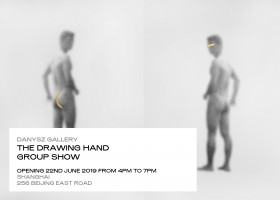What is drawing? Do drawing and painting have a different meaning in Chinese and in English? Can drawing be three-dimensional? Can drawing be dynamic? ……
Drawing, as a fundamental medium of artistic representation, has a variety of forms in the history of art, such as artistic writing, sketching, paper cutting, paper folding, or the wild and delicate lines under the artist’s hand. However, in contemporary art, as a medium to express ideas and concepts, drawing is a territory that allows for an infinity of forms and whose creative universe is extremely varied.
Pablo Picasso used to say, “Evidently one never knows what one is going to draw… but when one starts doingit, then a story is born, an idea… and there you go.”
With the aim of investigating the meaning of drawing through multiple aspects, Danysz Gallery makes “The Drawing Hand” a long-term exhibition project, which is dedicated to drawing in all its different forms, facilitates and encourages closer and more dynamic communications and interactions between Chinese and foreign artists.
Since 2007, “The Drawing Hand” has been a signature exhibition at Danysz Gallery. Based on five previous successful exhibitions, this summer, Danysz Gallery in Shanghai will proudly present the 6th edition of the exhibition “The Drawing Hand”, and invite once again its visitors to discover artworks from a rich selection of artists and to think through the meaning of drawing. The exhibition will be opened on next Saturday, 22nd June, 2019, and it will be on view until 31st August, 2019. This group show will include artists such as (the list below follows the alphabetical order of the artists’ last names):
aaajiao, Jef Aerosol, Berlina, Bianca Argimon, Tarek Benaoum, Jean-Charles de Castelbajac, Xiaoyi Chen, Chenyan Du, Guillaume Barborini, Yingjie Chen, Ben Edmunds, Chenyu Gong, Cecile Guettier, Jingfang HAO & Lingjie WANG, Jean-Samuel Halifi, Julia Haumont, Xiaoliang Huang, Feng Jin, Abdul Rahman Katanani, Kim Laughton, Jiying Lee, Hongbo Li, Shuiyang Liu, Yi Liu, Zhenchen Liu, Ludo, Lihua Ma, Malonne, Wenting Ma, Guanshuai Mao, Taras Milosevic, Salomé Partouche, Charles Petillon, Etienne Pottier, Sebastien Preschoux, Yingwei Pu, RadiKarl ArchiWe, Remi Rough, Georges Rousse, André Saraiva, Linghao Shen, Wei Shen, Siu, Soco, Xi Song, Yanchu Sun, Xin Wang, Tao Xia, Hao Xiang, Yiyang Yang, Diwen You, Michael Yu, Chong Zhang, Hong Zhao, Keke Zhang.
This exhibition involves artists from various geographical horizons — from Ludo to Maleonn —, each of them having invited another artist of their choice. It presents a pictorial language as varied as the myriad of interpretations suggested by the term “drawing”, including artworks made of strings, deep ink, paper cutting, paper folding, writing, or sculptural propositions that humorously resonate with the 80s, like Etch a Sketch. Giving total freedom of interpretation to the artists, “The Drawing Hand” proposes a portrait, dreamed of as exhaustive, of this rich and fertile ground.
On the white walls of the gallery, the artworks proliferate and spread all over in a dynamic and overwhelming exhibition layout. The viewer imagines the connections between the works. One tries to guess who invited whom… The viewer is continuously surprised by an unexpected medium or seduced by the exquisiteness of a pencil stroke. Drawing unites all these different forms of expression, and the works echo each other.
———————————————————-
“Funnily enough, what we mean by drawing isn’t the same thing in the western world as in Asia. We, at the gallery, are presenting this exhibition for the sixth time now since 2007. It revolves around this very simple concept: the artists featured in this exhibition—artists represented by Danysz, or simply friends of the gallery—were asked to present one or several drawings. But what exactly is drawing?
As often with cultural misunderstandings, confusion sprouts from language. In Chinese, drawing falls into the concept of a generic term for picture, painting, drawing. Like a wealthy and generous host, this term can accommodate a wide range of techniques, genres, practices, such as oil painting, sketching, comics, cartoon, traditional Chinese painting, western-style painting, etc. In Chinese, the emphasis is on the act of representing something—to paint, to draw a picture—and the finality of it, the actual representation—image, picture, drawing, painting.
In English however, drawing is not such a friendly host as the Chinese term. It isn’t such a lofty and elastic concept. In English, drawing doesn’t want to be mixed up with painting, and that is perhaps the most effective way to define it. Where painting usually demands the use of a brush to apply pigment, drawing traditionally keeps to its pens and pencils. Where painting unfolds as a full composition, with solid patches of color, drawing has more to do with “lines”, and indeed when they think of drawing, westerners often have in mind the “outline” of a representation.
Today it falls on you, visitors, as you wander about in the exhibition space, surrounded by such a rich collection of artworks, to settle this question: do you see the chinese term for drawing, or do you see drawing in the western sense? Or maybe both? But you might as well decide to discard these language categories altogether, and to do something less exposed to cultural landslides: you can decide to look, just look, and follow the artist’s hand.”
Magda Danysz, 2019
 Fr
Fr 中文
中文